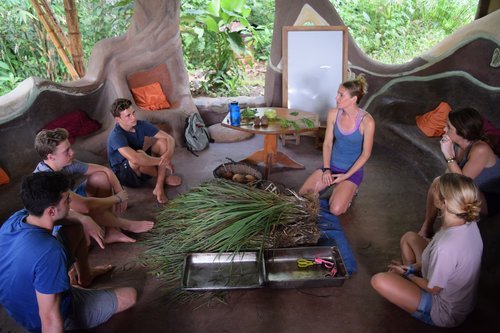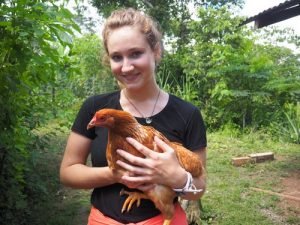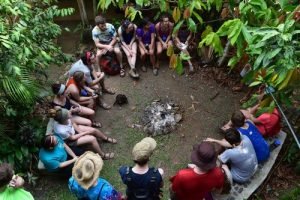
Invisible Infrastructure: How We Build Our Lives Together
This article was originally published by our partners at NuMundo. To see the original blog post please follow the link here.
Developing the physical infrastructure of our campus gets me up every morning. I don’t need coffee nor an alarm clock; I’m just excited to keep building. Building the orchards and earthworks, furniture for my home, a better feeder for our chickens; these are the projects that rev my permaculture engine. They are concrete, you can see the results of your physical labor immediately, and they are often the first projects of burgeoning permaculture sites. It requires little effort to dedicate the time, space, resources and money to these projects. Yet their impact on the success of a project, despite all this dedication, pales in comparison to another type of infrastructure; the invisible infrastructure.

Although much harder to apply, invisible infrastructures are the most crucial aspects of successful design. They are intangible elements which determine:
– how we exchange goods and services.
– how we transmit knowledge and information.
– how we make decisions in groups.
– how we take care of ourselves.
They are our economic, legal, and interpersonal arrangements and dynamics. For many of us drawn towards living and working with others in community, it is the invisible social arrangements or infrastructure that we must strive to understand.

STRUCTURAL CONFLICT
When working in community, the social structures become our guiding influence. They are the structured relationships which hold us together. They can be deliberately designed into the system–or they can be ignored.
Not choosing a decision making protocol, for example, does not mean there is an absence of decision making. Rather it means a pattern is generated spontaneously through a combination of each individual’s personality and position in the group, as well as cultural and social standards. This un-designed protocol may work for the group, but more often than not it defaults to a cultural status quo of how power is carried by different types of people, and eventually becomes what we call a structural conflict.
Just as you can eloquently or poorly design a garden, the same can be done with our social structures. When there is a lack of good design, structural conflict occurs, and usually arises from two major themes of group dynamics: purpose and power.
PURPOSE
Purpose begets our vision and mission statements: why we are here and what are we doing together to accomplish this vision? Conflict around purpose can be recognized when ordinary issues become unresolvable and when decision making stalemates occur.

A classic example of this structural conflict occurred a few years ago at the Ranch. Our goats had begun to cause discord and stress amongst our team. One side valued their products (milk and cheese) and the opportunity they provided for visitors to experience milking animals for the first time, while the other side was frustrated by the amount of effort needed to generate these products and the goat system’s larger lack of replicability and sustainability. Both sides understood each other, but it took many years and lots of conversations before a genuine agreement could be made about whether to keep the goats or not.
This agreement was only possible once our team stepped back to better determine our greater purpose (mission) and how the goats fit into this. We finally asked, as an education center, what type of education did we want to provide? Inspirational? The goats certainly accomplished this, it was often the highlight of short term groups and guests’ visits. Or was it a practical skill based education we wanted to provide? At times the goats accomplished this, but it was not the sustainable animal husbandry program that we dreamed of and at times marketed.
While our team all valued the inspirational side of the goats, in the end we decided we wanted to be teaching hard, practical skills, that were transferable outside our gate, and the goats too often failed to align with this purpose. We also realized that we could achieve the goal of inspiration in other areas that were simultaneously more productive.
The stress that this structural conflict caused often felt like a personality clash, but in reality the clash was between the perceived difference of our purpose. This is an important point: structural conflicts often appear to be personal conflicts, but they are rooted in the way our invisible infrastructure is designed.

POWER
Power, the other main structural conflict, can be defined as the ability to influence. When there exists an unequal distribution of this influence amongst the group, conflict occurs. Most commonly this is experienced through decision making.
This unmistakable conflict occurred back when our kitchen garden had too many cooks in the kitchen. It was unclear who was in charge and often the loudest voice won out. One long term volunteer in particular, felt very strongly about how the garden was supposed to be managed. If the moon cycle didn’t call for weeding then we were told not to weed, despite an abundance of eager labor. Someone would plant something and someone else would pull it up a week later. Volunteers were making important decisions that affected a valuable space, and as they transitioned out our core team was left with the remnants.
Two core team members, Rachel Jackson and Laura Killingbeck, recognized the need for consistency and efficiency. But the situation was complicated because so many people felt strongly about what the space was supposed to be. In order to do their jobs, Rachel and Laura both needed to be able to make decisions in the area, but knew that if they didn’t meet everyone’s needs the space would ultimately not succeed. The two of them teamed up to lead the rest of the group to set goals for the area. Once they gathered everyone’s input, they collated the goals and used them to design different options for the garden. They presented these options to the group, edited them based on group input, divided up the installation work, and carried it out.
Today it is this plan, created by two designers and based on the needs of the entire group, which holds the power over that space. Decision making still occurs with regard to the details, but the primary conflict–who gets to decide– has evaporated.
DECISION MAKING AT THE RANCH
There are many different forms of decision making; majority, concentrated power, consensus, and consensus minus one are common examples. At the Ranch, for the past year, we have been practicing consent decision making, adapted from the sociocracy governance framework. Consent is different from consensus.
Consensus decision making requires an affirmative from all group members to pass a proposal, and a single person in that group can also block that proposal. As many have experienced, this often leaves too much power with a single divergent viewpoint, which can stalemate any and all conversations.
Consent, on the other hand, also requires an affirmative from all group members to pass a proposal, but a single person can only block a proposal if they have a reasoned and paramount objection. A paramount objection is one of overriding importance, and means that something about the proposal will inhibit the individual from doing her or his job or from being well.
The philosophy of consent decision making is that the group functions as a single organism with shared goals. Each individual is a part of the organism. Therefore, the group actively asks members to reflect on proposals and express paramount objections when they arise, based on the idea that what is good for the individual will also be good for the group, and vice versa.

CREATING OUR LIVES TOGETHER
Perhaps the best book on this topic, originally recommended to us by our friend Nate Sanders, is Creating A Life Together by Diana Leafe Christian. Leafe Christian researched intentional communities and ecovillages around the United States to determine why so many fail and what patterns emerged from the successful examples.
The most prominent lesson from this research is that so many seeking community also find it difficult to work out their invisible infrastructure. Whether it stems from a belief, common in spiritual communities, that one’s group is mature beyond the need for these arrangements, or that those of us driven toward community have done so to remove ourselves from the legal and economic bureaucracy; it is apparent that many communities forget the power of these arrangements. They have the power to help us succeed or cause our demise.
For anyone seeking community, hoping to build their own ecovillage or permaculture cooperative farm, the following are the key invisible infrastructure that all successful community examples have in place.
Purpose and vision: Discussed above; are you on the same page about what you are trying to accomplish and how you will do so?
Decision making: Also discussed above as it relates to power. Agree upon a protocol and hold each other accountable.
Ownership structures: Be very clear about who owns what, power often resides here; and be very clear about how you would like to change this in the future.
Entry and exit strategies: How do new members join your groups and how do members leave, all without engendering resentment toward past time/money put in so that everyone is on an even playing field.
Finances: Get your house in order and be clear as day to how money can be spent, earned, and distributed.
Conflict resolution: Have a clear protocol for dealing with conflict. This doesn’t have to involve deep, new-age personal reflection but it does need to make everyone feel safe.
Communication: When, why, and how do you meet? Separate meetings for big picture, planning conversations from those of the day-to-day work.
We seek community because we want to live with other people. We want to cultivate deeper relationships. We might believe those relationships are bomb-proof, that the above organizational structures are unnecessary, but above all they do one thing really well; they protect our friendships. And this is why the eloquent design of these structures into our lives is the most important part of permaculture design.
RESOURCES
We the People: Consenting to a Deeper Democracy, A Guide to Sociocratic Principles and Methods by John Buck and Sharon Villines
Creating a Life Together: Practical Tools to Grow Ecovillages and Intentional Communities by Diana Leafe Christian

PERMACULTURE DESIGN CERTIFICATION COURSE
Are you interested in learning more about designing invisible infrastructure into your community? Join our community at Rancho Mastatal this April and May 2017 for our annual Permaculture Design Certification course. The course is taught by a diverse team of instructors and is ideal for anyone who wants to:
– Experience an established permaculture site in action.
– Devote two weeks to an intensive learning process.
– Learn from instructors who practice professional design and install work.
– Explore rural Costa Rica, swim in breathtaking waterfalls, eat delicious tropical food, drink homemade hooch, play lots of futbol and frisbee, and make lifelong friends!












